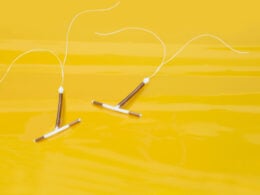In the wake of the Supreme Court’s overturning of Roe v. Wade, The New York Times recently reported on the increasing popularity of websites like “Plan C” that tell women wanting to end their pregnancies how to access the two-drug chemical abortion regimen, also known as DIY abortion, self-managed abortion, abortion pills, or at-home abortion, even if their state now bans or limits abortions. Additionally, USA Today reports that many women are wondering whether their access to emergency contraception (EC), colloquially referred to as Plan B, or “the morning after Pill,” is also affected by the abortion ruling.
The intention behind emergency contraception (EC) is to prevent pregnancy in the aftermath of unprotected sex, while the abortion pill regimen is intended to end an already-established pregnancy. Still, the two are often mistakenly conflated. Here, we’ll cover what Plan B is (and how it differs from abortion pills), how it works, how effective it is, and whether women can expect serious side effects from it.
[Author’s note: EC is an umbrella term including Plan B and other progestin-only products, ulipristal acetate (ella), copper IUDs, and what’s called the Yuzpe regimen (various combinations of birth control pills). Here we’re specifically covering progestin-only EC like Plan B, which has been available over-the-counter for women over age 17 since 2013.]What is Plan B, and how is it different from chemical abortion pills?
How Plan B works
We read from the product website that “Plan B One‑Step is progestin‑only emergency contraception that helps prevent pregnancy before it starts when taken within 72 hours after unprotected sex.” (Generic forms of Plan B function the same way, and include Take Action, Next Choice-One Dose, My Way, and Levonorgestrel Tablets.)
Whether the pills are brand-name or generic, their active ingredient is levonorgestrel, a synthetic progestin that’s been used in the birth control Pill (together with synthetic estrogen) for decades. Side effects are therefore similar to those experienced while on the Pill, and include: breast tenderness (10.7%), dizziness (11.2%), irregular bleeding and/or menstrual changes (26.3% of studied women experienced heavier or lighter periods), headache (16.8%), fatigue (16.9%), abdominal pain (17.6%), and nausea (23.1%). (Note that while Plan B’s side effects are purported to be minimal, a quick Google search reveals a handful of chat forums of women seeking more information on why they are still experiencing disrupted cycles for multiple months after taking a single dose of Plan B.)
Since pregnancy can only occur if sperm and good quality cervical mucus are present at the time of ovulation (release of a mature egg), the primary goal of Plan B is to prevent ovulation before it happens. Plan B is supposed to do this by stopping the luteinizing hormone (LH) surge that immediately precedes (and triggers) ovulation.
How chemical abortion pills work
Chemical abortion pills, on the other hand, are intended to end a pregnancy that has already begun. The abortion pill regimen involves two different medications taken sequentially. The first medicine, mifepristone (also known as RU-486 or Mifeprex), blocks the effects of the pregnancy hormone progesterone.
Normally, progesterone surges during the first trimester, causing the uterine lining (endometrium) to thicken in preparation for successful implantation of the developing embryo. Progesterone also prevents the uterus from contracting. (Note that for women who change their mind after taking just the first of the two abortion pill medications, abortion pill reversal, mentioned by Lila Rose during her abortion pill webcast for Natural Womanhood, attempts to directly counteract the effects of Mifeprex/RU-486/Mifepristone with a large dose of bioidentical progesterone.)
After mifepristone has presumably ended the pregnancy, the woman takes the second medication, misoprostol (also known as Cytotec) to cause preterm contractions to expel the dead embryo and all pregnancy-related tissue. While mifepristone is always taken orally as a pill, misoprostol (Cytotec) may also be self-inserted vaginally, as a suppository.
Prior to April 2021, chemical abortion pills were only available by prescription, and an in-office doctor visit was required for the administration of the first dose of the two-pill regimen. However, since April 2021, the in-person requirement was temporarily waived by the FDA, and abortion pills have increasingly been prescribed after a telehealth consultation, with the option to have pills shipped directly to patients via the mail. In December 2021, however, the FDA decided to permanently waive the in-person administration requirement–a move that has undoubtedly endangered the health and safety of some women, as we discussed in our Abortion Pill Webcast and in our interview with Dr. Ingrid Skop, OB/GYN.
How effective is Plan B at preventing pregnancy?
Now that we’ve established that Plan B primarily functions to prevent pregnancy, while the abortion pill regimen functions to end pregnancy, we’ll discuss how effective Plan B is at preventing pregnancy.
Plan B is most effective when taken in the first 24 hours (or up to 72 hours) after “unprotected” or “inadequately protected” sex. This means sex without condom use, or if the condom broke, or if the woman forgot to take her birth control pill that day. (Note that, like other forms of hormonal contraception, Plan B does not protect against sexually transmitted infections.) This is because Plan B is only intended to prevent ovulation, and if you were about to ovulate when you had sex, time is of the essence for preventing pregnancy.
Both the Plan B website and the FDA’s provider information and patient product insert explicitly note its brief window of effectiveness, and warn women not to think of it as regular contraception, cautioning that “it doesn’t provide long‑term protection against future pregnancy.” This is both because timing around ovulation is so vital for it to work, and because Plan B’s half life (the amount of time it’s active in the body) is very short.
If taken within three days (72 hours) of sex, according to the FDA’s packaging label for Plan B (last updated in 2017), “After a single act of intercourse occurring anytime during the menstrual cycle, the expected pregnancy rate of 8% (with no contraceptive use) was reduced to approximately 1% with Plan B.” In other words, having sex once on a random cycle day could normally be expected to lead to pregnancy 8% of the time, but in Plan B users, pregnancy occurred a little more than 1% of the time.
Canada’s version of the Plan B website reads, “If you take [Plan B] within 24 hours of unprotected sex, it is 95% effective. If you take it between 48 and 72 hours of unprotected sex, the efficacy rate is 61%.”
When it comes to Plan B’s effectiveness at preventing pregnancy, the stats don’t tell the whole story
However, what goes unacknowledged by the FDA and Planned Parenthood alike, is that because a woman is infertile for most of her menstrual cycle, Plan B shouldn’t be given credit for pregnancy prevention if a woman takes it while she is already naturally infertile anyway. If a woman is infertile, she’s not going to get pregnant after intercourse, with or without Plan B. She doesn’t need Plan B.
Plan B’s true efficacy can only be accurately measured in a population of women who take it when they are actually fertile. The only research study we know of that directly measured levonorgestrel contraceptive efficacy in women who were determined to be fertile (via ultrasound findings and blood draws) at the time they took it found it prevented pregnancy just 68% of the time. Keep in mind that this doesn’t mean 68% of women got pregnant anyway after taking Plan B. It means that of the pregnancies Plan B was expected to prevent, only 68% were actually prevented. In other words, the failure rate when a woman is in her fertile window may be as high as 32%.
Also of note, while the FDA recommends Plan B without regard to women’s weight, Planned Parenthood and other websites note that research from 2015 and 2017 found significantly higher rates of pregnancy (approx. 6%) in Plan B users who weighed more than 165 pounds. (The lead author recommended overweight or obese women have copper IUDs inserted for emergency contraception, instead, which we know comes with its own risks and side effects.) A recently released 2022 study found that merely doubling the dose of levonorgestrel (Plan B’s active ingredient) for overweight or obese women did not lead to greater effectiveness.
With FAMs and periodic abstinence, Plan B is uneccessary
We’ve now established that Plan B and the abortion pill regimen are not the same, although some mistakenly conflate the two terms. Plan B and other forms of emergency contraception are intended to prevent pregnancy by stopping ovulation. Chemical abortion is intended to stop a pregnancy already begun by depriving the developing embryo of vital nutrients and then causing the woman’s body to go into preterm labor to expel the remains. Plan B has to be taken within a few days of unprotected sex, whereas medication abortion pills are given up to nine weeks (or longer) since a woman’s last known menstrual period.
Most importantly, we’ve pointed out that if a woman wasn’t within her fertile window when she had sex, there’s no need to fear an unplanned pregnancy (and, consequently, no need to take Plan B). Women who use fertility awareness methods (FAMs) or methods of natural family planning (NFP) have the distinct advantage of knowing when intercourse is most likely to result in a pregnancy–and when it is not.
Couples who use FAM need not live in fear that pregnancy will simply “happen” to them, as they appreciate how their combined fertility (and the choices they make about when to have sex) operates, and they understand the need for periodic abstinence during the fertile window should they be seeking to avoid pregnancy. With FAMs that recommend periodic abstinence during the fertile window, there’s no need to run out for Plan B because a condom broke (incidentally, this is a good reminder why condoms actually decrease the efficacy of your FAM–more on that, here.) Unfortunately, women (and men) are woefully uneducated about the facts of sex and fertility–which pharmaceutical companies are clearly using to their financial advantage when they encourage the use of emergency contraception.
Click here to read our companion article detailing the data concerning whether or not Plan B may cause early abortions.
This article was last updated on January 31, 2023.
References:
[1] Edelman, Alison B et al. “Double Dosing Levonorgestrel-Based Emergency Contraception for Individuals With Obesity: A Randomized Controlled Trial.” Obstetrics and gynecology vol. 140,1 (2022): pp. 48-54. doi:10.1097/AOG.0000000000004717 [2] Festin M RR, et al. “Effect of BMI and body weight on pregnancy rates with LNG as emergency contraception: analysis of four WHO HRP studies.” Contraception. vol 95, no. 1 (2017): pp. 50-54. [3] Kapp, Nathalie et al. “Effect of body weight and BMI on the efficacy of levonorgestrel emergency contraception.” Contraception vol. 91, no. 2 (2015): pp. 97-104. doi:10.1016/j.contraception.2014.11.001










